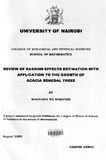| dc.contributor.author | Macharia, Wa Warothe | |
| dc.date.accessioned | 2013-05-22T09:20:17Z | |
| dc.date.available | 2013-05-22T09:20:17Z | |
| dc.date.issued | 2009 | |
| dc.identifier.citation | M.Sc (Statistics) | en |
| dc.identifier.uri | http://erepository.uonbi.ac.ke:8080/xmlui/handle/123456789/24398 | |
| dc.description.abstract | Estimation of random effects (variance components) IS a method often used in population
genetics and applied to areas such as animal and plant bleeding and growth. Scientists nowadays
feel lost if confronted with huge set of different random effects estimation methods. This is
especially because there exists no uniformly best method hence deciding which method should
be used is difficult to take. This paper gives an overview of maximum likelihood and restricted
maximum likelihood methods of estimating random effects applied to random coefficient models
and demostrates them by applying them in determining variability in the growth of Acacia
Senegal trees. We can say that both methods gives similar results with the dataset used. However
random effects estimated using maximum likelihood method are slightly less than those
estimated using restricted maximum likelihood methods. Random intercept and slope model is
more appropriate to use in determination of variability in growth of Acacia Senegal trees than
random intercept model.
Keywords: Maximum Likelihood, Restricted Maximum Likelihood, Random Effects, Random
Intercept Model, Random Intercept and Slope Model. | en |
| dc.description.sponsorship | University of Nairobi | en |
| dc.language.iso | en | en |
| dc.title | Review of random effects estimation with application to the growth of Acacia senegal trees | en |
| dc.type | Thesis | en |
| local.publisher | School of Mathematics, University of Nairobi | en |

